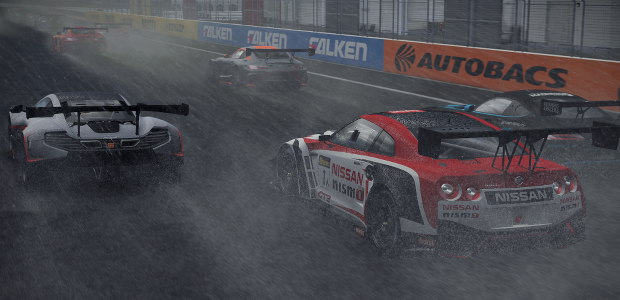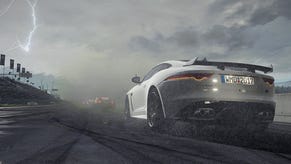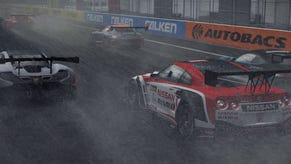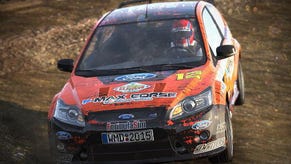Project Cars 2 is addressing the first game's flaws
I've taken some flak for how much I like the first Project Cars. No, it's not iRacing, but iRacing also doesn't have AI that is ready to start a race at precisely 1:33 AM on a Tuesday night, pause halfway through because the popcorn started popping and the pan needs to be jiggled, and then resume after a light snack. I'm busy, and often the last thing I want to add to my gaming is scheduling.
The first game was a solid experience with a good simulation, and it had a ton of options that allowed you to play in pretty much any way. Oh, and it was bloody beautiful. Project Cars 2 [official site] is an evolutionary step forward. It's much the same game, but the issues present in the first are getting some serious attention paid to them, and it all really comes down to better tire physics.
The four contact patches between road and tire are easily the most important thing in driving; they're the only major way a car interacts with the world. Yes, aero has a significant effect, but mostly aero is there to push the car down on those contact patches more at high speed. The big issue with the first Project Cars was that when you lost traction it was often all over, even if you should have been able to save it.
Project Cars 2 is dropping the massed, forum-based testing the first game went through and has moved from 30,000 testers down to 700, some of whom are professional racing drivers. That expertise is really showing in some of the detail. At the beginning of a session you're given warnings over the radio about warming your tires up, and by the end—when your tires are worn down, overheated, and squishy—the game does a great job of imparting the right feeling. Rather than the sharper snap of oversteer on a fresh tire, the back end on an old set oozes around a bit. The loss of traction is a bit easier, and a bit more linear. That sensation is particularly distinct on racing slicks, and I'm really happy to see Project Cars 2 putting a lot of effort into nailing those tire dynamics.
I do, however, still have a couple of issues with the physics in what I've played. All of the race cars I've driven have been solid, from karts to GT3 to formula cars, but when I've decided to play around with the road cars I've experienced unexpected amounts of understeer on some of them. The higher end cars work pretty well, but the more reasonably priced machines were giving me more trouble than I thought they would.
To make sure that I wasn't crazy, I loaded up the Mercedes-AMG A45 at the Willow Springs Horse Thief Mile, because I've had a good amount of seat time there in a CLA45 in real life, and I really clicked with that car on that track. I set good lap times, caught up with a C63, and overall just had a wonderful time. In game I'm having massive understeer again. Yes, it understeers a bit in the real world, but overall it's a sharp machine, and it felt remarkably neutral on turn-in. The real handling issue in the A45/CLA45 is that the AWD system is so front-biased that you can't be very aggressive getting back on the gas when exiting a corner. In game, I found myself having to kick the brakes hard to shift the car's weight forward dramatically, almost inducing oversteer, to get the front wheels to grip on turn-in.
I'm not quite sure whether the issue is me overcooking the turns due to the lessened sense of speed inherent in a simulation or whether the drive to make the race cars demonstrably better than the road cars lead the developers to reduce the road cars' capabilities too much. I suspect it might be a bit of column A and a bit of column B. I might be going in a little too fast simply because a home sim rig can't come close to providing the kind of information that a real car's chassis sends right into your ass and the development time thus far may have been mostly spent on the flagship cars that everybody wants to see. I'm hoping my A45 gets significantly better by release.
Moreover, Project Cars 2's force feedback from the wheel could stand to be a bit more robust, especially when communicating wheel slip. My Fanatec Clubspot is giving me the amount of information I expect from a road car in a formula car, and the road cars feel a bit like they're floating.
This issue extends to the low traction surfaces a bit as well. Rallycross cars on the dirt section of a track feel a bit like they're floating on the surface, rather than digging down into the dirt to get to the good grip. That said, the chassis dynamics, weight shift, and ability to control a slide are way better than Project Cars 1, and that has enabled the team to add this whole new discipline to the repertoire.
The thing I'm liking the most is simply how much the game lets you play it however you want. There are 182 cars, and 46 tracks, and you can mix and match. If you want to take a rallycross car for race with 32 other cars around the Indianapolis Motor Speedway in a blizzard, you can do that. It's goofy, but goofy can be fun so go ahead. I did, and it was a blast. I wouldn't recommend doing in real life, as it was extremely hazardous, but I also don't recommend shooting a rocket at your own feet while jumping and then hitting people with a shovel in real life.
I spent a lot of my time messing around in custom races and testing to get a feel for how accurate the simulation was, but once I was done revelling in the lovely lighting, crashing a Ford Focus RX into the brickyard's walls, and cursing at the A45, I stepped into career mode. There are five different disciplines covering the gamut from formula cars to sports cars to endurance prototypes to rallycross, but I chose to start — in a most realistic fashion — as a kid in a kart.
A few corners in to my first race and I'm puttering into the grass, watching the competition zoom ahead, and hearing “In case you hadn't noticed, your wheel fell off” over the radio. While I did eventually start winning, most of my losses in that first series were due to errant wheels. They pop off like Lego.
Finishing that first contract and getting into a car where the wheels usually stayed on was a relief. Once you've signed a contract to race in a series you're in it, and there's no backing out, so a wiser me chose to test my next car's wheel sturdiness in some custom races before jumping back into my career. Just as the career started to get a little monotonous I got an entry to a one-off invitational, which was a nice way to have a diversion from my primary career goals while still contributing. It's a feature that should be in more racing games.
All in all, Project Cars 2 seems to be shaping up to be the game we all hoped the first one would be. Given that I very much enjoyed the first one, I'm excited to see the finished version of this one... as long as that A45 gets a little love.
Note: Project Cars 2's preview build was played with a Fanatec Clubsport Wheel, Pedals, and Shifter on an Aorus x7. The full game is out on September 22nd, 2017.

















